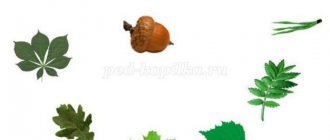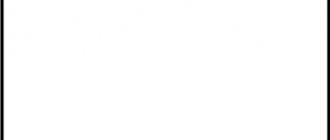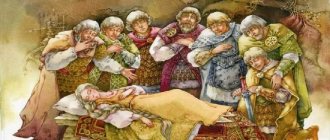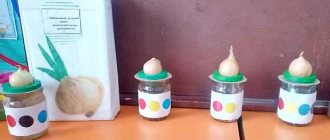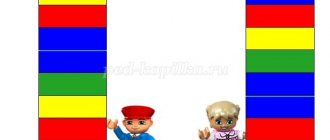Federal State Educational Standard Abstract OOD Construction “Building a fence” (junior preschool age)
OOD on design in the second junior group “Building a fence”
Goal: to develop the ability to build a simple structure as shown by an adult. Name the parts of the building material - bricks. Develop the ability to name colors correctly. Develop interest in design and attention.
Program content: To develop children’s ability to build a fence by placing bricks in a row, combining and alternating their positions by color; teach to play with buildings; show interest in the actions of a friend; develop the ability to put cubes into a box, taking into account the color.
Material: each child has bricks and toys: squirrel, dog, cat
Vocabulary work: bricks, fence, smallest side, wide side.
Methods and techniques: demonstration of a sample, showing, explanation, questions, repetition, encouragement, artistic expression, help.
Motivation: Let's help the animals.
Progress:
Educator: Children, sit on the chairs and listen to what I tell you. Animals came to visit us, but they were very upset. Do you know why? The squirrel told me that they all lived together, helped each other, and they had a beautiful fence that protected them from evil animals. But suddenly a strong wind came and broke the fence, the animals are now afraid, and they came to you asking for help. Children, let's help the squirrel and everyone else?
Children: Let's help!
Physical education minute:
Educator: Look what’s on my table.
Children: Bricks
Educator: What color are the bricks?
Children: (Answers).
Educator: Correct. From these bricks we will build a fence for the animals. Look, the bricks have the smallest side, so we’ll put the brick on it. Children, we have an uneven fence, what needs to be done?
Children: (silent).
Educator: But you need to turn them with the wide side towards me. Show Maxim where the wide side of the brick is?
Maxim: Here she is.
Educator: That's right, here is the wide side of the brick. What a beautiful fence we have made. Now let's hide our animals behind him. That's right, and I'll see which fence is the most beautiful and durable. I looked carefully, everyone turned out to have beautiful and durable fences. Well done boys. Come on, tell Sasha where your dog is.
Sasha: Behind the fence.
Educator: Correct. Dasha, show me where your cat is hiding.
Dasha: Here, behind the fence.
Educator: That's right, Dasha. Look, all the animals are happy, they liked your fences. Now we know that they are not afraid of any animals.
Summary of a design lesson in the second junior group. Topic: “Fence for the vegetable garden”
Municipal budgetary preschool educational institution kindergarten No. 8
Summary of a design lesson in the second junior group.
Topic: “Fence for the vegetable garden”
Compiled by: teacher
first qualification category
Sarapul -2016
Summary of a design lesson in the second junior group.
Educator:
Topic: “Fence for the vegetable garden”
Goal: to consolidate children’s ability to correctly name the parts of a construction set (cubes, bricks); correctly name the color of the part; create a lasting interest in children in playing with buildings.
Preliminary work: looking at the picture “vegetable garden”; consideration of various building schemes and building them individually (in the evening); drawing on the theme “a fence for animals in the zoo”; looking at the fence around the kindergarten while walking; conversation between parents and children at home on the topic “what is a fence for?”
Material: large cardboard, with a picture of a vegetable garden (beds) in the middle; multi-colored builder's set.
Progress of the lesson.
Playback Guys, today I went to kindergarten and on the way I met Mishka (bear). He was very upset about something. When I asked him what happened to him, he cried even harder. I invited him to visit us. Maybe you will be able to find out about his trouble?
Bear. (crying)
Reb. They approach the bear and ask what happened to him.
Bear. (wiping tears) I planted a lot of carrots to treat my friends - the bunnies - in the fall (he cries again, the children calm him down). But then the wolves came running and trampled my entire garden!! (cries)
Playback Oh! What should we do, guys? How can we help our guest in his trouble?
Reb. Plant carrots again!!
Playback Fine! What if the wolves come running again and trample the garden? You and I need to come up with something so that the wolves don’t trample on the garden anymore!
Reb. Build a fence!!!
Bear. And I don't know how to build a fence.
Playback What to do?
Reb. Let's teach!
Playback Great idea. What forms will we build from?
Reb. Made from bricks!
Playback Great! Let's try with bricks. Bear, what color do you want the fence? Look how many colorful bricks the guys have!
Bear. I think it would be great if the fence was green. I really like this color.
The guys take green bricks and build a fence around the “garden” on cardboard.
Bear. (joyfully) hurray! Now I will plant a lot of carrots for my friends - bunnies and for new friends - kids. I’ll run into the forest to build a fence around my garden! Thanks guys for teaching me. Goodbye
Get text
MAGAZINE Preschooler.RF
Municipal educational preschool institution "Kindergarten of a combined type "Ryabinka"" of the municipal formation Kozelsky district of the Kaluga region Artistic and creative activity (construction) in the second junior group “Multi-colored fences” Prepared and conducted by: Teacher of the highest category Cheglokova Lyubov Vladimirovna Sosensky 2014 Artistic and creative activity (construction) in the second junior group “Multi-colored fences” Purpose: To learn to distinguish and name such building parts as bricks, to construct elementary buildings by combining familiar forms of building material, introduce the dependence of the stability of parts on their location on the plane. Objectives: Learn to place bricks horizontally along a quadrangle, placing them close to each other. Reinforce knowledge of primary colors. Develop a desire to build buildings according to your own plans, combine them according to the plot and play them out. Foster a desire to take care of feathered friends. Handout: Construction set for each child; toys: birds (sparrows). Cardboard of different colors. Demonstration material: Toy cat bi-ba-bo. Preliminary work: Outdoor game: “Sly cat” Psycho-gymnastics: “Bird” Examination of various buildings made from small and large construction sets.Progress of the lesson:
Organizing time. A recording of birds (sparrows) singing sounds - Children, whose song is this? -Where do sparrows live? A sparrow appears. And here is the sparrow, look how small he is. - What color are the sparrow’s feathers and wings? — What color is a sparrow’s beak? Now listen to a story that happened to a sparrow and his friends. One day the sparrows were sitting in a clearing and chirping merrily, and from behind the bushes the cat Vaska was watching them, just wanting to drag the sparrows away. Guys, let's help our friends the sparrows, build a fence so that the rogue cat cannot interfere with them. But for this we need building material. Look, there is building material on my table. What are these details called (showing bricks, children’s answers). From these bricks we will build a strong, strong fence. The bricks need to be placed on the narrow long side, close to each other, at the very edge of the clearing, so that the cunning cat does not get to the sparrows. To make the fence beautiful, we will build it from bricks of different colors. Phys. Minute “Happy Sparrows”. Independent work of children. Children are building a fence around the clearing. A cheerful flock of sparrows appears and settles behind children’s fences in colorful meadows. The cheerful song of Vaska the cat sounds. On behalf of the cat Vaska, an analysis of children's works is carried out. And so that our cat Vaska can make friends with the sparrows, let’s all play a game together. Outdoor game: “Vaska the Cat.” Well done guys. Did you like the game? For such durable and beautiful fences, the sparrows have prepared a surprise for you. They give surprises.
| Next > |
Summary of a design lesson in the middle group “Fences and Fences”
Fences and fences
…
Target. Exercise children in closing space by arranging planar figures; in distinguishing and naming the four primary colors (red, blue, yellow, green) and geometric shapes (square, triangle, circle, rectangle); consolidate ideas about the main construction parts and parts of the designer (cube, brick, block); teach to understand an adult, think, find your own solutions.
Material. A cube (a red cube from a building set, on one side of which eyes and a mouth are glued), a box with building material, an envelope, paper plane models of various shapes, pencils, felt-tip pens.
Progress
Get your children interested in a fairy-tale plot, set them up emotionally, and try to create an expectation of the unusual, magical, and mysterious. Introduce them to the Cube. Chat with them on behalf of Kubik, invite the guys to visit him in the magical country of Formandia, where you can only get by completing tasks. Ask a riddle:
I have a box, my friends live in it. They are very different, Yellow, red, Green and blue, All friendly and strong. They love to gather together and turn into buildings. (Box with cubes, construction set)
Working with the illustration “Door to Formandia”.
Draw the children's attention to the picture (Fig. 1) and tell them that it shows a door to the country of Formandia. Offer to find the keys to the door at the bottom of the sheet (square, round, triangular and rectangular), cut off the strip on which they are depicted, cut it along the lines into pieces and cut out the shapes.
Invite the children to “open” the door to Formandia with keys, placing them on appropriately shaped locks. Praise them for completing the task correctly, ask them to collect the keys and put them in an envelope.
On behalf of Kubik, invite the guys to a magical land.
Working with illustrations “Let’s go for a visit.”
Invite each child to choose one of the proposed pictures (Fig. 2, 3, 4, 5).
Talk with the children about the content of the pictures: “Who did we come to visit? What is shown in the pictures? Why does the bunny need so many apples? What color are apples? How many apples does a bunny carry in a car? What is the cat doing? And so on".
Rice. 1
Rice. 2
Rice. 3
Rice. 4
Rice. 5
Invite the children to color the pictures. Find out what color and what they paint. Advise to color small parts with felt-tip pens, and large parts with pencils.
While working, read poems to the children that correspond to the content of the pictures:
The bunny's apples are ripe in the garden. Red lanterns burned on the branches. Look at the cat, at the cat, at the painter, the cat paints and sings, invites us to visit him: “Pur, pur!” Petya, Petya, cockerel, Petya - a ringing voice. Petya is strict, Petya is important, Petya is strong and brave. Here is a green friend - a bug-eyed frog, sitting by the pond in the morning and looking at the float.
Invite the children to look at the colored pictures and identify what is in all four pictures. (Fences.)
Let the children carefully examine the fences.
Working with the illustration “Fence with a patterned lattice.”
Invite the children to look at the illustration (Fig. 6) and think about the question: “What could be behind this fence?” and build beautiful fences from building material. Teach them to build several options for fences on the table from any parts of 2-3 types and colors.
Look at the fences with your children, highlight familiar details. Let them choose any toys and build fences, fences, fences for them (a sand yard for dolls, a pool for swimmers, a pond for ducks, a corral for horses, etc.). The children choose the shape of the fence themselves (take sheets of colored paper in round, square, rectangular, triangular shapes, place them on the table and begin to build them).
At the end of the work, admire the buildings with the children, consider how different the fences turned out, what color and shape they consist of.
Then offer the children a construction set, for example, Lego Duplo bricks. Let the children invent and build any kind of fences from them. As you work, ask them how regular building parts differ from Lego Duplo parts and how Lego Duplo parts are held together.
Game tasks.
Construction of fences, aquariums, lakes, flower beds, parking lots, etc. Construction of fences with and without support models, showing construction methods (indicative parts are installed at the four corners, then the distance between them is built).
Rice. 6
Tips for a teacher
Encourage children to independently analyze buildings; teach to talk about what parts are made of and how they are built; encourage a harmonious combination of details in shape and color, independence, and contact with peers and adults. Help develop game stories; offer to carefully dismantle buildings and structures, lay out parts, and put them back in place.
Keep a notebook for notes (conclusions about the activities of the children, their successes, failures, questions; records of children's words, original, unusual judgments, funny remarks, extraordinary manifestations).
Keywords
Square, triangle, circle, rectangle, cube, brick, block.

